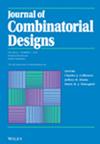求助PDF
{"title":"谱半径上某些Nordhaus–Gaddum型结果的推广","authors":"Junying Lu, Lanchao Wang, Yaojun Chen","doi":"10.1002/jcd.21919","DOIUrl":null,"url":null,"abstract":"<p>Let <math>\n <semantics>\n <mrow>\n <mi>G</mi>\n </mrow>\n <annotation> $G$</annotation>\n </semantics></math> be a simple graph and <math>\n <semantics>\n <mrow>\n <mi>λ</mi>\n \n <mrow>\n <mo>(</mo>\n \n <mi>G</mi>\n \n <mo>)</mo>\n </mrow>\n </mrow>\n <annotation> $\\lambda (G)$</annotation>\n </semantics></math> the spectral radius of <math>\n <semantics>\n <mrow>\n <mi>G</mi>\n </mrow>\n <annotation> $G$</annotation>\n </semantics></math>. For <math>\n <semantics>\n <mrow>\n <mi>k</mi>\n \n <mo>≥</mo>\n \n <mn>2</mn>\n </mrow>\n <annotation> $k\\ge 2$</annotation>\n </semantics></math>, a <math>\n <semantics>\n <mrow>\n <mi>k</mi>\n </mrow>\n <annotation> $k$</annotation>\n </semantics></math>-edge decomposition <math>\n <semantics>\n <mrow>\n <mo>(</mo>\n \n <mrow>\n <msub>\n <mi>H</mi>\n \n <mn>1</mn>\n </msub>\n \n <mo>,</mo>\n \n <mi>…</mi>\n \n <mo>,</mo>\n \n <msub>\n <mi>H</mi>\n \n <mi>k</mi>\n </msub>\n </mrow>\n \n <mo>)</mo>\n </mrow>\n <annotation> $({H}_{1},{\\rm{\\ldots }},{H}_{k})$</annotation>\n </semantics></math> is <math>\n <semantics>\n <mrow>\n <mi>k</mi>\n </mrow>\n <annotation> $k$</annotation>\n </semantics></math> spanning subgraphs such that their edge sets form a <math>\n <semantics>\n <mrow>\n <mi>k</mi>\n </mrow>\n <annotation> $k$</annotation>\n </semantics></math>-partition of the edge set of <math>\n <semantics>\n <mrow>\n <mi>G</mi>\n </mrow>\n <annotation> $G$</annotation>\n </semantics></math>. In this paper, we obtain some sharp lower and upper bounds for <math>\n <semantics>\n <mrow>\n <mi>λ</mi>\n \n <mrow>\n <mo>(</mo>\n \n <msub>\n <mi>H</mi>\n \n <mn>1</mn>\n </msub>\n \n <mo>)</mo>\n </mrow>\n \n <mo>+</mo>\n \n <mi>⋯</mi>\n \n <mo>+</mo>\n \n <mi>λ</mi>\n \n <mrow>\n <mo>(</mo>\n \n <msub>\n <mi>H</mi>\n \n <mi>k</mi>\n </msub>\n \n <mo>)</mo>\n </mrow>\n </mrow>\n <annotation> $\\lambda ({H}_{1})+\\,\\cdots \\,+\\lambda ({H}_{k})$</annotation>\n </semantics></math> in terms of the clique number of <math>\n <semantics>\n <mrow>\n <msub>\n <mi>H</mi>\n \n <mi>i</mi>\n </msub>\n </mrow>\n <annotation> ${H}_{i}$</annotation>\n </semantics></math> and the size of <math>\n <semantics>\n <mrow>\n <mi>G</mi>\n </mrow>\n <annotation> $G$</annotation>\n </semantics></math>, and discuss what <math>\n <semantics>\n <mrow>\n <mi>k</mi>\n </mrow>\n <annotation> $k$</annotation>\n </semantics></math>-edge decomposition <math>\n <semantics>\n <mrow>\n <mo>(</mo>\n \n <mrow>\n <msub>\n <mi>H</mi>\n \n <mn>1</mn>\n </msub>\n \n <mo>,</mo>\n \n <mi>…</mi>\n \n <mo>,</mo>\n \n <msub>\n <mi>H</mi>\n \n <mi>k</mi>\n </msub>\n </mrow>\n \n <mo>)</mo>\n </mrow>\n <annotation> $({H}_{1},{\\rm{\\ldots }},{H}_{k})$</annotation>\n </semantics></math> can maximize <math>\n <semantics>\n <mrow>\n <mi>λ</mi>\n \n <mrow>\n <mo>(</mo>\n \n <msub>\n <mi>H</mi>\n \n <mn>1</mn>\n </msub>\n \n <mo>)</mo>\n </mrow>\n \n <mo>+</mo>\n \n <mi>⋯</mi>\n \n <mo>+</mo>\n \n <mi>λ</mi>\n \n <mrow>\n <mo>(</mo>\n \n <msub>\n <mi>H</mi>\n \n <mi>k</mi>\n </msub>\n \n <mo>)</mo>\n </mrow>\n </mrow>\n <annotation> $\\lambda ({H}_{1})+\\cdots \\,+\\lambda ({H}_{k})$</annotation>\n </semantics></math> when <math>\n <semantics>\n <mrow>\n <mi>G</mi>\n </mrow>\n <annotation> $G$</annotation>\n </semantics></math> is a complete graph. These generalize some Nordhaus–Gaddum-type results on spectral radius for <math>\n <semantics>\n <mrow>\n <mi>k</mi>\n \n <mo>=</mo>\n \n <mn>2</mn>\n </mrow>\n <annotation> $k=2$</annotation>\n </semantics></math>, due to Nosal, Hong and Shu, and Nikiforov.</p>","PeriodicalId":15389,"journal":{"name":"Journal of Combinatorial Designs","volume":"31 12","pages":"701-712"},"PeriodicalIF":0.8000,"publicationDate":"2023-09-21","publicationTypes":"Journal Article","fieldsOfStudy":null,"isOpenAccess":false,"openAccessPdf":"","citationCount":"0","resultStr":"{\"title\":\"Generalizations of some Nordhaus–Gaddum-type results on spectral radius\",\"authors\":\"Junying Lu, Lanchao Wang, Yaojun Chen\",\"doi\":\"10.1002/jcd.21919\",\"DOIUrl\":null,\"url\":null,\"abstract\":\"<p>Let <math>\\n <semantics>\\n <mrow>\\n <mi>G</mi>\\n </mrow>\\n <annotation> $G$</annotation>\\n </semantics></math> be a simple graph and <math>\\n <semantics>\\n <mrow>\\n <mi>λ</mi>\\n \\n <mrow>\\n <mo>(</mo>\\n \\n <mi>G</mi>\\n \\n <mo>)</mo>\\n </mrow>\\n </mrow>\\n <annotation> $\\\\lambda (G)$</annotation>\\n </semantics></math> the spectral radius of <math>\\n <semantics>\\n <mrow>\\n <mi>G</mi>\\n </mrow>\\n <annotation> $G$</annotation>\\n </semantics></math>. For <math>\\n <semantics>\\n <mrow>\\n <mi>k</mi>\\n \\n <mo>≥</mo>\\n \\n <mn>2</mn>\\n </mrow>\\n <annotation> $k\\\\ge 2$</annotation>\\n </semantics></math>, a <math>\\n <semantics>\\n <mrow>\\n <mi>k</mi>\\n </mrow>\\n <annotation> $k$</annotation>\\n </semantics></math>-edge decomposition <math>\\n <semantics>\\n <mrow>\\n <mo>(</mo>\\n \\n <mrow>\\n <msub>\\n <mi>H</mi>\\n \\n <mn>1</mn>\\n </msub>\\n \\n <mo>,</mo>\\n \\n <mi>…</mi>\\n \\n <mo>,</mo>\\n \\n <msub>\\n <mi>H</mi>\\n \\n <mi>k</mi>\\n </msub>\\n </mrow>\\n \\n <mo>)</mo>\\n </mrow>\\n <annotation> $({H}_{1},{\\\\rm{\\\\ldots }},{H}_{k})$</annotation>\\n </semantics></math> is <math>\\n <semantics>\\n <mrow>\\n <mi>k</mi>\\n </mrow>\\n <annotation> $k$</annotation>\\n </semantics></math> spanning subgraphs such that their edge sets form a <math>\\n <semantics>\\n <mrow>\\n <mi>k</mi>\\n </mrow>\\n <annotation> $k$</annotation>\\n </semantics></math>-partition of the edge set of <math>\\n <semantics>\\n <mrow>\\n <mi>G</mi>\\n </mrow>\\n <annotation> $G$</annotation>\\n </semantics></math>. In this paper, we obtain some sharp lower and upper bounds for <math>\\n <semantics>\\n <mrow>\\n <mi>λ</mi>\\n \\n <mrow>\\n <mo>(</mo>\\n \\n <msub>\\n <mi>H</mi>\\n \\n <mn>1</mn>\\n </msub>\\n \\n <mo>)</mo>\\n </mrow>\\n \\n <mo>+</mo>\\n \\n <mi>⋯</mi>\\n \\n <mo>+</mo>\\n \\n <mi>λ</mi>\\n \\n <mrow>\\n <mo>(</mo>\\n \\n <msub>\\n <mi>H</mi>\\n \\n <mi>k</mi>\\n </msub>\\n \\n <mo>)</mo>\\n </mrow>\\n </mrow>\\n <annotation> $\\\\lambda ({H}_{1})+\\\\,\\\\cdots \\\\,+\\\\lambda ({H}_{k})$</annotation>\\n </semantics></math> in terms of the clique number of <math>\\n <semantics>\\n <mrow>\\n <msub>\\n <mi>H</mi>\\n \\n <mi>i</mi>\\n </msub>\\n </mrow>\\n <annotation> ${H}_{i}$</annotation>\\n </semantics></math> and the size of <math>\\n <semantics>\\n <mrow>\\n <mi>G</mi>\\n </mrow>\\n <annotation> $G$</annotation>\\n </semantics></math>, and discuss what <math>\\n <semantics>\\n <mrow>\\n <mi>k</mi>\\n </mrow>\\n <annotation> $k$</annotation>\\n </semantics></math>-edge decomposition <math>\\n <semantics>\\n <mrow>\\n <mo>(</mo>\\n \\n <mrow>\\n <msub>\\n <mi>H</mi>\\n \\n <mn>1</mn>\\n </msub>\\n \\n <mo>,</mo>\\n \\n <mi>…</mi>\\n \\n <mo>,</mo>\\n \\n <msub>\\n <mi>H</mi>\\n \\n <mi>k</mi>\\n </msub>\\n </mrow>\\n \\n <mo>)</mo>\\n </mrow>\\n <annotation> $({H}_{1},{\\\\rm{\\\\ldots }},{H}_{k})$</annotation>\\n </semantics></math> can maximize <math>\\n <semantics>\\n <mrow>\\n <mi>λ</mi>\\n \\n <mrow>\\n <mo>(</mo>\\n \\n <msub>\\n <mi>H</mi>\\n \\n <mn>1</mn>\\n </msub>\\n \\n <mo>)</mo>\\n </mrow>\\n \\n <mo>+</mo>\\n \\n <mi>⋯</mi>\\n \\n <mo>+</mo>\\n \\n <mi>λ</mi>\\n \\n <mrow>\\n <mo>(</mo>\\n \\n <msub>\\n <mi>H</mi>\\n \\n <mi>k</mi>\\n </msub>\\n \\n <mo>)</mo>\\n </mrow>\\n </mrow>\\n <annotation> $\\\\lambda ({H}_{1})+\\\\cdots \\\\,+\\\\lambda ({H}_{k})$</annotation>\\n </semantics></math> when <math>\\n <semantics>\\n <mrow>\\n <mi>G</mi>\\n </mrow>\\n <annotation> $G$</annotation>\\n </semantics></math> is a complete graph. These generalize some Nordhaus–Gaddum-type results on spectral radius for <math>\\n <semantics>\\n <mrow>\\n <mi>k</mi>\\n \\n <mo>=</mo>\\n \\n <mn>2</mn>\\n </mrow>\\n <annotation> $k=2$</annotation>\\n </semantics></math>, due to Nosal, Hong and Shu, and Nikiforov.</p>\",\"PeriodicalId\":15389,\"journal\":{\"name\":\"Journal of Combinatorial Designs\",\"volume\":\"31 12\",\"pages\":\"701-712\"},\"PeriodicalIF\":0.8000,\"publicationDate\":\"2023-09-21\",\"publicationTypes\":\"Journal Article\",\"fieldsOfStudy\":null,\"isOpenAccess\":false,\"openAccessPdf\":\"\",\"citationCount\":\"0\",\"resultStr\":null,\"platform\":\"Semanticscholar\",\"paperid\":null,\"PeriodicalName\":\"Journal of Combinatorial Designs\",\"FirstCategoryId\":\"100\",\"ListUrlMain\":\"https://onlinelibrary.wiley.com/doi/10.1002/jcd.21919\",\"RegionNum\":4,\"RegionCategory\":\"数学\",\"ArticlePicture\":[],\"TitleCN\":null,\"AbstractTextCN\":null,\"PMCID\":null,\"EPubDate\":\"\",\"PubModel\":\"\",\"JCR\":\"Q3\",\"JCRName\":\"MATHEMATICS\",\"Score\":null,\"Total\":0}","platform":"Semanticscholar","paperid":null,"PeriodicalName":"Journal of Combinatorial Designs","FirstCategoryId":"100","ListUrlMain":"https://onlinelibrary.wiley.com/doi/10.1002/jcd.21919","RegionNum":4,"RegionCategory":"数学","ArticlePicture":[],"TitleCN":null,"AbstractTextCN":null,"PMCID":null,"EPubDate":"","PubModel":"","JCR":"Q3","JCRName":"MATHEMATICS","Score":null,"Total":0}
引用次数: 0
引用
批量引用

 求助内容:
求助内容: 应助结果提醒方式:
应助结果提醒方式:


